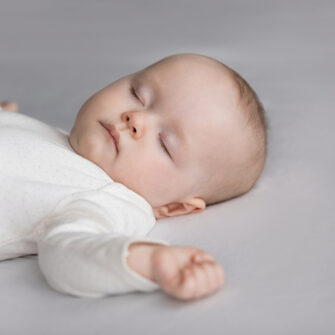
October is Safe Sleep and SIDS Awareness Month
Sudden Infant Death Syndrome (SIDS). Sudden Unexpected Infant Death (SUID). Accidental suffocation or strangulation in bed. Sleep-related infant death.
Medical examiners, researchers and child safety experts use these labels to define the tragic death of an otherwise healthy baby, usually during sleep. In the United States, we lose about 3,700 infants this way each year, with no warning signs.
Thankfully, we have made considerable progress in understanding these devastating events in recent years. There is so much overlap in the scenarios we see with SIDS, SUID and suffocation, we combine them into a single set of prevention strategies called “safe sleep” — and this knowledge has been put into action.
In recent years, the U.S. passed legislation banning inclined sleepers and crib bumpers, enacted new safety standards for crib mattresses, released updated recommendations on safe infant sleep practices, and initiated a number of recalls targeting nursery products unsafe for sleep (including rockers, swings, pillows, infant seats, etc.). A new effort is aimed at banning a dangerous new product category – weighted infant sleepwear.
As a mom myself, I know that there’s so much change for parents to keep track of — I understand the instinct to focus on getting baby to sleep at all, let alone safely. But I urge you to take the time to catch up with what we have learned. Do not allow your worries about baby waking up to distract you from the bigger concern — a baby who does not wake up.
The American Academy of Pediatrics recommends the following “Safe Infant Sleep” guidelines, up to baby’s first birthday:
Take care of yourself. Start prenatal care early and go to all your OB appointments. Avoid nicotine, alcohol, marijuana, opioids and other illicit drugs, during and after pregnancy. If you smoke or vape, now is the time to quit. The equivalent of one cigarette per day in pregnancy doubles the risk of a sudden infant death. Take a breastfeeding class and reach out to a lactation consultant if you are struggling.
Take care of your baby. Attend all their pediatric visits. Follow the CDC’s recommended vaccine schedule. Feed baby human milk if you can, for as long as possible. Provide supervised, awake “tummy time” to develop the upper body right from the start — working up to 15-30 minutes total per day by 7 weeks.
Set up a safe nursery. Baby should sleep in a safe crib, bassinet or pack-n-play for every sleep (naps and nighttime). Use a firm, flat, non-inclined sleep surface with a snugly fitted sheet. Don’t add anything else — no bumpers, blankets, pillows, soft toys, mattress toppers or the next viral baby accessory-of-the-week. Place the baby’s bed in your bedroom, if you can, as room-sharing has shown to be protective. But do not bring baby into your bed because that increases risk significantly. Avoid commercial at-home cardio-respiratory monitors, as they are not medical grade and are known to be unreliable.
What are unsafe infant sleep locations?
- Adult beds, couches, chairs
- Held by, or next to, anyone who is asleep
- Any product with a harness — swings, bouncers, car seats (outside of the car)
- Inclined surfaces that elevate baby’s head
- Pillows, including nursing pillows
- Crib made before 2011, or a bassinet before 2014
- Any recalled sleep device (visit CSPC.gov and sign up for recall notifications)
Put baby to bed safely. There is no perfect room temperature for infant sleep, but overheating is a known risk factor. Keep a comfortable room temperature and dress baby in layers for warmth instead of using blankets. It is common for them to need one more layer than you do. Hats should come off when indoors as they can cause baby to overheat. A sleep sack or footed pajamas can be a safe top layer, but never use a weighted sleep sack or blanket. Swaddling is fine but stop when baby shows signs of attempting to roll over, often by 2-4 months. Always place baby on their back for sleep. Older babies sometimes decide they would rather sleep on their tummy — if they can get there on their own you can let them stay, but always start them on their back. Offer a pacifier for sleep, but do not worry if they do not want it or it falls out.
What if baby cries in their safe sleep space?
Be responsive and gentle, but also consistent over time. Babies are sensitive to routine, so try to establish safe patterns early. Try placing a sleepy baby in their safe sleep space before fully asleep, so they can experience falling asleep there. Patting, jiggling, singing or white noise may help. Remember that sleep problems are easier to prevent than they are to solve, and bad (unsafe) habits will be even harder to break later. Accept offers of help from trusted family and friends.
Teach all of baby’s caregivers about safe sleep. A disturbingly high number of sleep-related infant deaths occur at day care or while with a babysitter. Do not assume childcare providers, family members and neighbors are up to date with current recommendations. Make sure they understand that following your safe sleep rules is non-negotiable; these guidelines from The American Academy of Pediatrics apply until baby’s first birthday.
Is this information new to you? Try not to judge yourself too harshly. Safety guidelines are always a work-in-progress as data comes in and we continue to learn more. As a mom, I feel you, and I know how hard parenting is. And as a health educator, I recognize that when we know better, we do better. If you have not been following these guidelines so far, be gentle with yourself, and resolve to do better. Your baby is worth the effort.
This post was originally published in 2023 and updated in 2024.